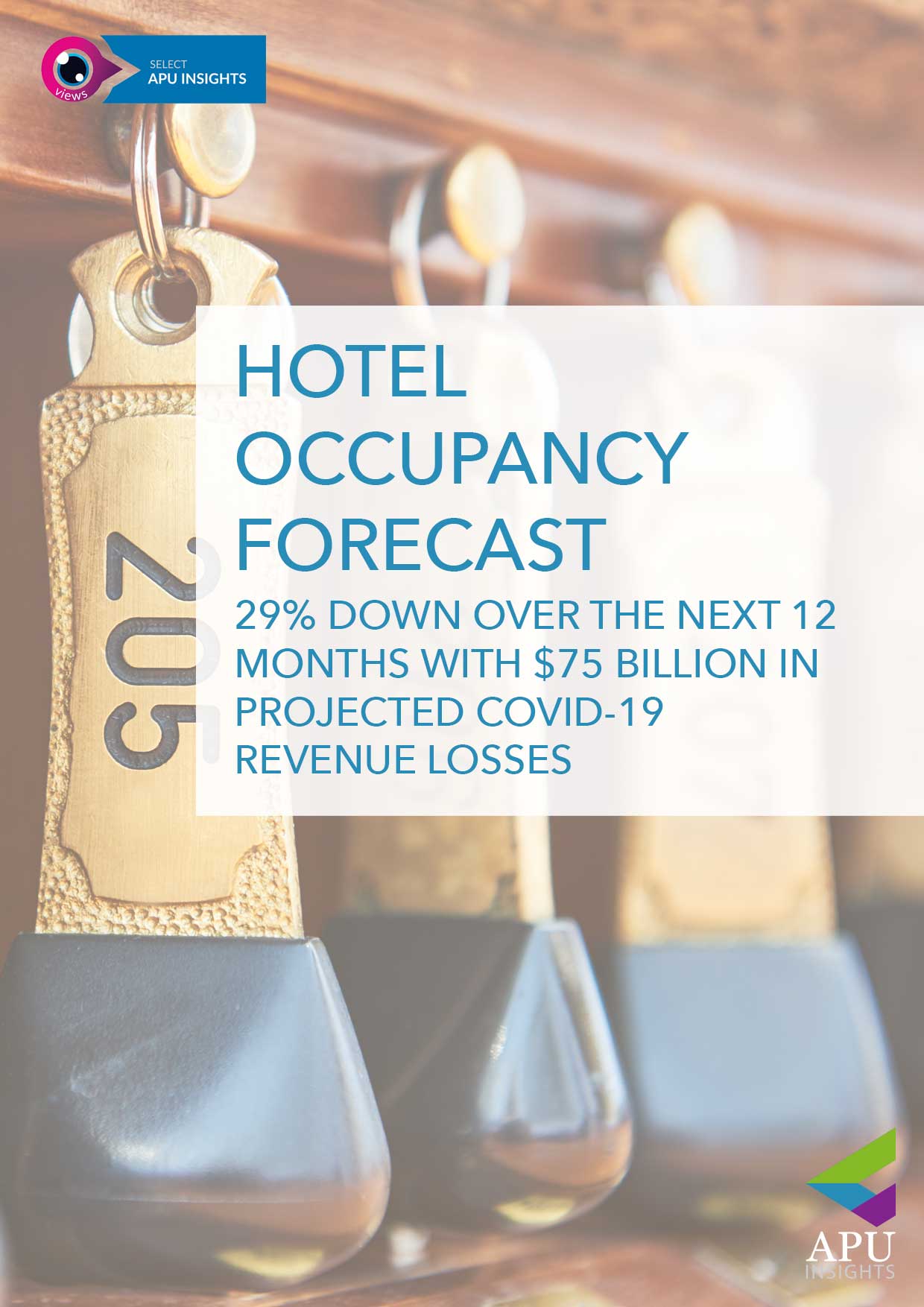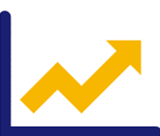

Hotel occupancy forecast | 29% down over the next 12 months with $ 75 Billion in projected COVID-19 revenue losses
Hotel occupancy forecast | 29% down over the next 12 months with $ 75 Billion in projected COVID-19 revenue losses
Dr. Evangelo Damigos; PhD | Head of Digital Futures Research Desk
- Travel
- Economic Growth
- Competitive Differentiation
Publication | Update: Nov 2020

The ongoing impact of the COVID-19 pandemic will lead to a 29% decline in annual hotel occupancy over the next 12 months, resulting in a projected revenue loss for the industry of about $ 75 Billion in room revenue alone.
The estimate is according to the Magid HTL Forecast Tracker, analyzed in conjunction with Horwath HTL, the world’s oldest, largest, and most experienced hotel, tourism, and leisure-consulting brand.
The forecast shows declines being driven by business and leisure travel intentions alike, but consumer sentiment for attending a meeting or conference over the next 12 months was the most telling showing a projected decline of 22%. Additionally, while travel incidence is being impacted, the research shows that frequency intention remains stable from pre-COVID levels. This suggests that while a smaller percentage plan to travel in the future, those that do plan to travel are likely to do so at a frequency that resembles their pre-COVID behavior.
The Magid HTL Forecast Tracker uses a baseline of self-reported consumer travel behavior that was collected 12 months prior to the pandemic breakout in March 2020. Travel intentions subsequently are being collected at various time intervals to assess changes in intention. Both “Reach,” representing the percentage of the population who plan at least one travel experience within the designated time frame, and “Frequency,” representing the anticipated number of experiences for the designated time frames, are considered in the forecast. This data is then used to determine the trajectory of the expected time to return to “normal,” as well as whether there has been a significant upturn or downturn in travel intention from the previous wave.
“The forecast shows the continuing significant impact COVID is having on hotel occupancy,” says Rick Garlick, Vice President, Strategy Consultant, Magid. “Currently, the forecast suggests a 39% decline in occupancy for the next month. If the average occupancy at this time of the year (summer) is 70%, this would put current occupancy around 43%.”
“Many hotel companies are creating new forecast models for the remainder of this year and next without the benefit of insight into the mindset of the traveling consumer,” said John Fareed, Chairman, Horwath HTL, America. “This data will allow hoteliers to better understand the customer’s intentions and create marketing offers to consumers that will position them to survive and thrive this crisis.”
The most recent wave of research, which was conducted July 29th to August 2nd, shows that 71% of consumers expect to next stay in a hotel 24 months from now. That is down from the baseline behavior of 89% who said so in March and the 74% who said the same in the beginning of June. Only 56% of consumers said they expected to next stay in a hotel a year from now, compared to 62% who said so in June and 79% who reported the same in March.

According to the most recent wave, consumers anticipate staying at hotels 7.26 times per year. That frequency is actually up from the June research, where consumers reported an intention of 6.74 times per year and from the “baseline” reported behavior of 6.58 times per year.
The data suggests a brighter outlook for vacation rentals, with travelers having a higher trust level than with hotels.
While vacation rentals are anticipated to be down for the short term, the Magid HTL Forecast Tracker suggests their recovery will be much quicker. While vacation rentals are currently forecasted to be down 64% for the last part of the summer, they are expected to return to normal in 12 months.
Airline travel intentions are paralleling hotel intentions, with the current forecast more pessimistic than in the previous wave. Within the next 12 months, air travel is expected to decline 31%, in line with the expected 29% drop in occupancy.
Magid HTL Forecast Tracker, analyzed in conjunction with Horwath HTL, says COVID-driven declines span both business and leisure travel intentions
About Magid: Magid is a consumer-centered business strategy company delivering courageous thinking that shapes better experiences, products and services. Since 1957, thousands of local and global brands in over 40 countries have engaged the firm for bold ideas that have helped achieve innovation and success. The Magid team is passionately curious and driven by the pursuit of improving human experiences with every engagement.
About Horwath HTL: Horwath HTL (www.horwathhtl.com) is the world’s oldest, largest, and most experienced hotel, tourism, and leisure consulting brand, with forty-five offices in thirty-nine countries. Horwath HTL is a member of Crowe Global, the 8th largest accounting network consisting of 36,500 employees, working in more than 220 firm offices in 130 countries.
 Digital Themes: Travel, Economic Growth, Competitive Differentiation
Digital Themes: Travel, Economic Growth, Competitive Differentiation

HTML
 Access Rights | Content Availability:
Access Rights | Content Availability: 


Objectives and Study Scope
This study has assimilated knowledge and insight from business and subject-matter experts, and from a broad spectrum of market initiatives. Building on this research, the objectives of this market research report is to provide actionable intelligence on opportunities alongside the market size of various segments, as well as fact-based information on key factors influencing the market- growth drivers, industry-specific challenges and other critical issues in terms of detailed analysis and impact.
The report in its entirety provides a comprehensive overview of the current global condition, as well as notable opportunities and challenges.
The analysis reflects market size, latest trends, growth drivers, threats, opportunities, as well as key market segments. The study addresses market dynamics in several geographic segments along with market analysis for the current market environment and future scenario over the forecast period.
The report also segments the market into various categories based on the product, end user, application, type, and region.
The report also studies various growth drivers and restraints impacting the market, plus a comprehensive market and vendor landscape in addition to a SWOT analysis of the key players.
This analysis also examines the competitive landscape within each market. Market factors are assessed by examining barriers to entry and market opportunities. Strategies adopted by key players including recent developments, new product launches, merger and acquisitions, and other insightful updates are provided.
Research Process & Methodology

We leverage extensive primary research, our contact database, knowledge of companies and industry relationships, patent and academic journal searches, and Institutes and University associate links to frame a strong visibility in the markets and technologies we cover.
We draw on available data sources and methods to profile developments. We use computerised data mining methods and analytical techniques, including cluster and regression modelling, to identify patterns from publicly available online information on enterprise web sites.
Historical, qualitative and quantitative information is obtained principally from confidential and proprietary sources, professional network, annual reports, investor relationship presentations, and expert interviews, about key factors, such as recent trends in industry performance and identify factors underlying those trends - drivers, restraints, opportunities, and challenges influencing the growth of the market, for both, the supply and demand sides.
In addition to our own desk research, various secondary sources, such as Hoovers, Dun & Bradstreet, Bloomberg BusinessWeek, Statista, are referred to identify key players in the industry, supply chain and market size, percentage shares, splits, and breakdowns into segments and subsegments with respect to individual growth trends, prospects, and contribution to the total market.
Research Portfolio Sources:
Global Business Reviews, Research Papers, Commentary & Strategy Reports
M&A and Risk Management | Regulation

The future outlook “forecast” is based on a set of statistical methods such as regression analysis, industry specific drivers as well as analyst evaluations, as well as analysis of the trends that influence economic outcomes and business decision making.
The Global Economic Model is covering the political environment, the macroeconomic environment, market opportunities, policy towards free enterprise and competition, policy towards foreign investment, foreign trade and exchange controls, taxes,
financing, the labour market and infrastructure.
We aim update our market forecast to include the latest market developments and trends.
Review of independent forecasts for the main macroeconomic variables by the following organizations provide a holistic overview of the range of alternative opinions:
As a result, the reported forecasts derive from different forecasters and may not represent the view of any one forecaster over the whole of the forecast period. These projections provide an indication of what is, in our view most likely to happen, not what it will definitely happen.
Short- and medium-term forecasts are based on a “demand-side” forecasting framework, under the assumption that supply adjusts to meet demand either directly through changes in output or through the depletion of inventories.
Long-term projections rely on a supply-side framework, in which output is determined by the availability of labour and capital equipment and the growth in productivity.
Long-term growth prospects, are impacted by factors including the workforce capabilities, the openness of the economy to trade, the legal framework, fiscal policy, the degree of government regulation.
Direct contribution to GDP
The method for calculating the direct contribution of an industry to GDP, is to measure its ‘gross value added’ (GVA); that is, to calculate the difference between the industry’s total pretax revenue and its total boughtin costs (costs excluding wages and salaries).
Forecasts of GDP growth: GDP = CN+IN+GS+NEX
GDP growth estimates take into account:

Market Quantification
All relevant markets are quantified utilizing revenue figures for the forecast period. The Compound Annual Growth Rate (CAGR) within each segment is used to measure growth and to extrapolate data when figures are not publicly available.
Revenues
Our market segments reflect major categories and subcategories of the global market, followed by an analysis of statistical data covering national spending and international trade relations and patterns. Market values reflect revenues paid by the final customer / end user to vendors and service providers either directly or through distribution channels, excluding VAT. Local currencies are converted to USD using the yearly average exchange rates of local currencies to the USD for the respective year as provided by the IMF World Economic Outlook Database.
Industry Life Cycle Market Phase
Market phase is determined using factors in the Industry Life Cycle model. The adapted market phase definitions are as follows:

The Global Economic Model
The Global Economic Model brings together macroeconomic and sectoral forecasts for quantifying the key relationships.
The model is a hybrid statistical model that uses macroeconomic variables and inter-industry linkages to forecast sectoral output. The model is used to forecast not just output, but prices, wages, employment and investment. The principal variables driving the industry model are the components of final demand, which directly or indirectly determine the demand facing each industry. However, other macroeconomic assumptions — in particular exchange rates, as well as world commodity prices — also enter into the equation, as well as other industry specific factors that have been or are expected to impact.
Forecasts of GDP growth per capita based on these factors can then be combined with demographic projections to give forecasts for overall GDP growth.
Wherever possible, publicly available data from official sources are used for the latest available year. Qualitative indicators are normalised (on the basis of: Normalised x = (x - Min(x)) / (Max(x) - Min(x)) where Min(x) and Max(x) are, the lowest and highest values for any given indicator respectively) and then aggregated across categories to enable an overall comparison. The normalised value is then transformed into a positive number on a scale of 0 to 100. The weighting assigned to each indicator can be changed to reflect different assumptions about their relative importance.

The principal explanatory variable in each industry’s output equation is the Total Demand variable, encompassing exogenous macroeconomic assumptions, consumer spending and investment, and intermediate demand for goods and services by sectors of the economy for use as inputs in the production of their own goods and services.
Elasticities
Elasticity measures the response of one economic variable to a change in another economic variable, whether the good or service is demanded as an input into a final product or whether it is the final product, and provides insight into the proportional impact of different economic actions and policy decisions.
Demand elasticities measure the change in the quantity demanded of a particular good or service as a result of changes to other economic variables, such as its own price, the price of competing or complementary goods and services, income levels, taxes.
Demand elasticities can be influenced by several factors. Each of these factors, along with the specific characteristics of the product, will interact to determine its overall responsiveness of demand to changes in prices and incomes.
The individual characteristics of a good or service will have an impact, but there are also a number of general factors that will typically affect the sensitivity of demand, such as the availability of substitutes, whereby the elasticity is typically higher the greater the number of available substitutes, as consumers can easily switch between different products.
The degree of necessity. Luxury products and habit forming ones, typically have a higher elasticity.
Proportion of the budget consumed by the item. Products that consume a large portion of the
consumer’s budget tend to have greater elasticity.
Elasticities tend to be greater over the long run because consumers have more time to adjust their behaviour.
Finally, if the product or service is an input into a final product then the price elasticity will depend on the price elasticity of the final product, its cost share in the production costs, and the availability of substitutes for that good or service.
Prices
Prices are also forecast using an input-output framework. Input costs have two components; labour costs are driven by wages, while intermediate costs are computed as an input-output weighted aggregate of input sectors’ prices. Employment is a function of output and real sectoral wages, that are forecast as a function of whole economy growth in wages. Investment is forecast as a function of output and aggregate level business investment.


 Industry: Travel, Leisure and Hospitality
Industry: Travel, Leisure and Hospitality 
